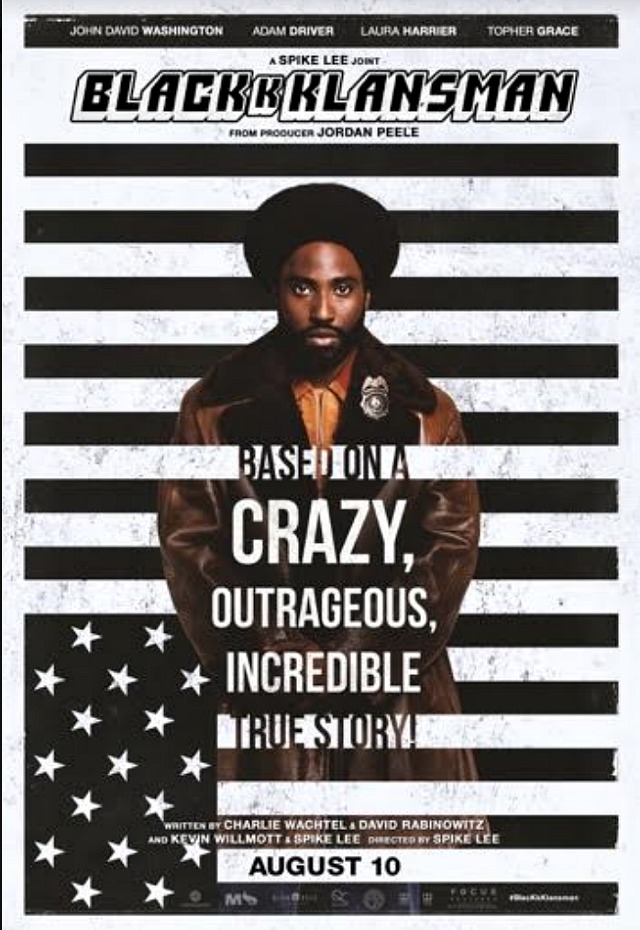So the black-and-white backdrop is supposed to raise associations with prison or chain-gang garb…right?
The true-life, written-about story behind Spike Lee‘s Black Klansman is a little bizarre, but I wouldn’t call it “crazy,” “outrageous” or ‘incredible” as much as odd and head-scratchy.
BlacKkKlansman is basically a police undercover caper film, based on Ron Stallworth’s 2014 novel (“Black Klansman: Race, Hate, and the Undercover Investigation of a Lifetime”).
At times it tonally feels like Starsky and Hutch or even to some extent like John Badham‘s Stakeout, especially as it involves the main cop protagonist falling in love with a girl (in this case an Afro’ed black activist played by Laura Harrier) who shouldn’t know what he’s up to, but whom he eventually confesses to. In this sense John David Washington‘s Stallworth is Richard Dreyfuss in the Badham film, and Adam Driver (as partner Flip Zimmerman) is Emilio Estevez.

At times the film also reminds you of some Clarence Williams III scenes from The Mod Squad.
Set in 1972, pic isn’t literally about Stallworth joining the Ku Klux Klan but a stealthy undercover investigation of the Klan, initiated when he was the first black detective in the history of the Colorado Springs Police Department.
After initial correspondence with the Klan, Stallworth received a call in which he was asked if he wants to “join our cause.” Stallworth answered affirmatively, and in so doing launched an audacious, fraught-with-peril inquiry.
SPOILER-ISH BUT NOT REALLY: Right away you’re telling yourself, “Yes, I know this actually happened and that Lee is using the facts in Stallworth’s book, but it made no sense for Fallworth to be heavily involved in this operation.” And it just feels crazy as you’re watching one crazy incident after another.
Problem #1 is that throughout the film Stallworth talks to KKK members on the phone (including wizard David Duke, played by Topher Grace) and so Zimmerman, pretending to be the Real McCoy, has to sound like Stallworth as much as possible.
Except this is a dicey game that’s unlikely to fool anyone. Early on a local KKK leader tells Stallworth that his voice sounds different, which it obviously is.
If I was Stallworth’s supervisor I would tell him he’ll make a mistake sooner or later and that he’s too much of a red flag, and that the smart move is for Zimmerman to carry the ball alone.
Problem #2 comes when a KKK member spots “a black guy” (i.e., Stallworth) behind the wheel of a car that’s following as he drives with Zimmerman. Brilliant tactical maneuvering, Stallworth!
Problem #3 happens when Zimmerman is told by a suspicious klan member to submit to a lie-detector test, and so Stallworth, knowing that Zimmerman’s in a tough spot, runs up to the KKK member’s house and throws a rock through a window…it just seems nuts for Stallworth to have done that, given the likelihood that the klan might wonder why a black guy happened to be nearby.
Problem #4 occurs when the same looney-tunes KKK member looks up Stallworth’s address in the phone book and pays him a visit. Stallworth answers the door and for a couple of minutes he and the KKK member eyeball each other.
Problem #5 happens when a Colorado Springs police supervisor insanely orders Stallworth to provide security for David Duke during a visit to their city. Before you know it Stallworth is in the same room as the same KKK member who knocked on his door, his identity protected only by a pair of shades. And then he takes them off before posing for a Polaroid photo. It’s just crazy — no undercover cop would behave this way.
All this aside, BlacKkKlansman is edgy and involving as far as it goes, and occasionally quite funny from time to time. It’s a good film, and I love that Lee shoots Trump between the eyes at the end, but people calling it “great” need to calm down.









